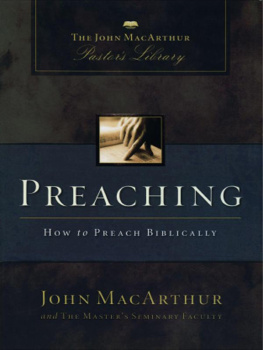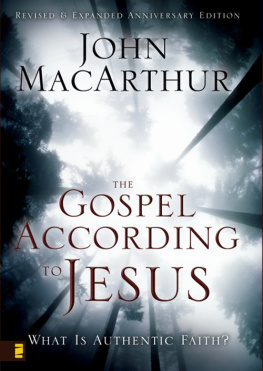HARD TO BELIEVE
WORK BOOK
UNDERSTANDING THE HIGH COST AND
INFINITE VALUE OF FOLLOWING JESUS
JOHN MACARTHUR

Copyright 2004 by John MacArthur
All rights reserved. No portion of this book may be reproduced, stored in a retrieval system, or transmitted in any form or by any meanselectronic, mechanical, photocopy, recording, scanning, or otherexcept for brief quotations in critical reviews or articles, without the prior written permission of the publisher.
Published in Nashville, Tennessee, by Thomas Nelson, Inc.
Published in association with the literary agency of Wolgemuth & Associates, Inc.
Unless otherwise noted, Scripture quotations are from the THE NEW KING JAMES VERSION. Copyright 1979, 1980, 1982, 1990, 1994 by Thomas Nelson, Inc., Publishers.
Scripture quotations noted NASB are from the taken from the New American Standard Bible, Copyright 1960, 1962, 1963, 1968, 1971, 1972, 1973, 1975, 1977, 1995 by The Lockman Foundation. Used by permission.
Produced with the assistance of The Livingstone Corporation (www.LivingstoneCorp.com). Project staff includes Elly Johnson, Emily Malone, Christopher D. Hudson, Neil Wilson, and Linda Taylor.
ISBN 0-7852-6346-2
Printed in the United States of America
04 05 06 07 08 VG 7 6 5 4 3 2 1
CONTENTS
(Hard to Believe Introduction and Chapter 1)
(Hard to Believe Chapter 2)
( Hard to Believe Chapter 3)
(Hard to Believe Chapter 4)
(Hard to Believe Chapter 5)
(Hard to Believe Chapter 6)
(Hard to Believe Chapter 7)
(Hard to Believe Chapter 8)
(Hard to Believe Chapter 9)
(Hard to Believe Chapter 10)
(Hard to Believe Chapter 11)
(Hard to Believe Chapter 12)
HOW TO USE THIS
COMPANION WORKBOOK
T his workbook has been written to enhance your experience of reading my hardcover book Hard to Believe. In this workbook, as always, I encourage you to continuously cross-check the Scriptures Im using and to grapple with the passages upon which I base my teaching. In large measure, Hard to Believe represents a directed study of the biblical passages that will shape your thinking about what it means to be a true follower of Jesus Christ.
The content of the book has been divided so that the introduction and twelve chapters can be studied personally and/or discussed by a small group in twelve sessions. The individual lessons have been based on the assumption that a reader will desire to review the content in the book and reflect on the implications for his or her own life.
Groups using this workbook for Hard to Believe are encouraged to provide each member with a personal copy of the book and workbook for participation. Leaders are advised that the final pages of each lesson include notes and specific answers to factual questions. These should assist them in lesson preparation.
LESSON COMPONENTS
The lessons in this workbook include the following components:
BIBLICAL FOCUSLists the primary Bible passages to which I refer in developing the material in the lesson chapter.
READING ASSIGNMENTLists the particular chapter in the book that relates to the lesson.
ANOTHER LOOKA set of questions to facilitate review of the content of the chapter in the book.
BIBLICAL CONNECTIONSQuestions that focus on the biblical passages related to the particular ideas discussed in each lesson.
HIGHLIGHTING THE LESSONQuestions that will allow you to review your understanding of the central teaching points I have developed from the Scriptures.
LASTING IMPLICATIONSThese questions assist you in drawing personal conclusions from Gods Word regarding the requirements of true belief.
In addition, you will find:
SIDEBARSThought-provoking quotes taken from Hard to Believe.
DAILY ASSIGNMENTSFive sets of questions for each lesson to allow you to personally review the content of the lesson.
BEARING THE CROSSThe close of each Daily Assignment will allow the participant to engage in one of Jesus habits: prayer.
FOR LEADERSA section of notes and suggested answers for selected questions.
May you be challenged and blessed as you discover what
it means to be a true follower of Jesus Christ.
THE COST
BIBLICAL FOCUS
Key passages from this section of the book: Matthew 16:24-25; Matthew 10:34-36; Luke 9:23-26.
READING ASSIGNMENT
Read both the introduction and chapter 1 of Hard to Believe.
ANOTHER LOOK
The following questions will help you review the material you read in the book.
1. The introduction to Hard to Believe sets the stage for what it costs to follow Christ today: The world is filled with millions of people who think they are headed for heavenbut they are deadly wrong. Probably most people think heaven awaits them, but it doesnt. But what is especially sad, is that many of those people sit in evangelical churches misinformed! (p. ix). What was your initial reaction to this challenge that many Christians who believe they are headed to heaven have been misinformed? Why?

2. In your opinion, how does the title of chapter 1, Tastes Great, Less Filling, represent the authors concern about how some churches are presenting the gospel?

3. One example of the cost of being Jesus disciple is found in Luke 14:26, when Jesus said, If anyone comes to Me, and does not hate his own father and mother and wife and children and brothers and sisters, yes, and his own life, he cannot be My disciple (NASB). How does Jesus statement point to the lite-ness of many gospel presentations today?

4. What similarities do you see between false teachers in the ancient world as described in 2 Timothy 3:1-2 and the man-centered self-esteem gospel that eventually became the seeker-friendly movement (p. 4) in our churches today?

5. What institutions appear to endorse Christianity Lite (see the following excerpt)? In what ways do you think their watered-down approach has affected their success or popularity?
Its Christianity for consumers: Christianity Lite, the redirections, watering down, and misinterpretation of the biblical gospel in an attempt to make it more palatable and popular. It tastes great going down and settles light. It seems to salve your feelings and scratch your itch; its custom-tailored to your preferences.
Hard to Believe, p. 2
BIBLICAL CONNECTIONS
These questions will allow you to think through the biblical passages used in this particular lesson.
6. Read Luke 9:23-26. Jesus gave three commands for anyone who wants to be a Christian. Describe in your own words what these three things mean.
deny yourself: ________________________________
take up your cross daily: ______________________
Next page






















